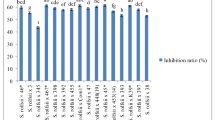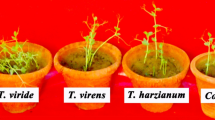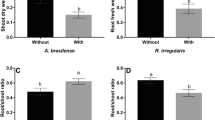Abstract
Rhizoctonia solani is an economically important pathogen of sugar beet (Beta vulgaris L.) causing seedling damping-off, and root and crown rot. Cultural practices, partially resistant cultivars, and fungicides are among the methods most used to manage R. solani. Penicillium pinophilum, a potential biocontrol agent for Rhizoctonia damping-off, was isolated from sugar beet. Our objective was to evaluate the biocontrol potential of P. pinophilum against R. solani AG 2–2 under laboratory and greenhouse conditions. In vitro co-culture of both fungi showed that R. solani growth was inhibited by P. pinophilum. A greenhouse inoculation study was done using sclerotia of R. solani and a conidia suspension of P. pinophilum to evaluate the response of a Rhizoctonia susceptible cultivar. Treatments included R. solani sclerotia, P. pinophilum conidia suspension, a combination of R. solani sclerotia with P. pinophilum conidia suspension, and a mock inoculation with water (control). One 2-cm deep furrow was made in the middle of peat filled trays into which 10 seeds were planted. Each treatment was applied adjacent to each seed and covered with peat. There were four replicates per treatment arranged in a completely randomized design. The sole sclerotia treatment caused 75% damping-off and severe root rot on surviving plants whereas the combination of sclerotia with P. pinophilum conidia suspension reduced damping-off by 50%. No damping-off incidences were observed with the P. pinophilum conidia suspension or the mock-inoculated control. It was concluded that P. pinophilum has the potential to reduce damping-off caused by R. solani but use of the most appropriate P. pinophilum concentration and its mitigation mechanisms need further studies.



Similar content being viewed by others
References
Abada, K.A. 1994. Fungi causing damping-off and root-rot on sugar-beet and their biological control with Trichoderma harzianum. Agriculture, Ecosystems and Environment 51: 333–337.
Abdel-Rahim, I.R., and K.A.M. Abo-Elyousr. 2018. Talaromyces pinophilus strain AUN-1 as a novel mycoparasite of Botrytis cinerea, the pathogen of onion scape and umbel blights. Microbiological Research 212–213: 1–9.
Adams, P.B., and G.C. Papavizas. 1970. Onion white rot caused by Sclerotium cepivorum as affected by soil temperature, PH, and inoculum density. Phytopathology 60: 1281.
Armentrout, V.N., and A.J. Downer. 1987. Infection cushion development by Rhizoctonia solani on cotton. Phytopathology 77: 619–623.
Armentrout, V.N., A.J. Downer, D.L. Grasmick, and A.R. Weinhold. 1987. Factors affecting infection cushion development by Rhizoctonia solani on cotton. Phytopathology 77: 623–630.
Behn, A., E. Ladewig, R. Manthey, and M. Varrelmann. 2012. Resistance testing of sugar beet varieties against Rhizoctonia solani. Sugar Industry-Zuckerindustrie 137: 49–57.
Benyagoub, M., S.H. Jabaji-Hare, G. Banville, and P.M. Charest. 1994. Stachybotrys elegans: A destructive mycoparasite of Rhizoctonia solani. Mycological Research 98: 493–505.
Blazier, S.R., and K.E. Conway. 2004. Characterization of Rhizoctonia solani isolates associated with patch diseases on turfgrass. Proceedings of the Oklahoma Academy of Science 84: 41–51.
Boine, B., A.C. Renner, M. Zellner, and J. Nechwatal. 2014. Quantitative methods for assessment of the impact of different crops on the inoculum density of Rhizoctonia solani AG2-2IIIB in soil. European Journal of Plant Pathology 140: 745–756.
Boland, G.J., M.S. Melzer, A. Hopkin, V. Higgins, and A. Nassuth. 2004. Climate change and plant diseases in Ontario. Canadian Journal of Plant Pathology 26 (3): 335–350.
Brantner, J.R., and C.E. Windels. 2009. Prevalence and distribution of Rhizoctonia solani AG 2–2 ISGs in sugar beet-growing areas of Minnesota and North Dakota with different crop rotations. Phytopathology 99: S15–S16.
Buhre, C., C. Kluth, K. Buercky, B. Maerlaender, and M. Varrelmann. 2009. Integrated control of root and crown rot in sugar beet: Combined effects of cultivar, crop rotation, and soil tillage. Plant Disease 93: 155–161.
Buttner, G., M.E.F. Ithurrart, and J. Buddemeyer. 2002. Root and crown rot Rhizoctonia solani - distribution, economic importance and concepts of integrated control. Zuckerindustrie 127: 856–866.
Carling, D.E., S. Kuninaga, and K.A. Brainard. 2002. Hyphal anastomosis reactions, rDNA-internal transcribed spacer sequences, and virulence levels among subsets of Rhizoctonia solani anastomosis group-2 (AG-2) and AG-BI. Phytopathology 92: 43–50.
Dircks, C., B. Boine, and M. Varrelmann. 2014. Effect of crop rotation and crop residues on the Rhizoctonia inoculum potential in soil. Sugar Industry-Zuckerindustrie 139: 241–249.
Djebali, N., S. Elkahoui, W. Taamalli, K. Hessini, B. Tarhouni, and M. Mrabet. 2014. Tunisian Rhizoctonia solani AG3 strains affect potato shoot macronutrients content, infect faba bean plants and show in vitro resistance to azoxystrobin. Australasian Plant Pathology 43: 347–358.
Engelkes, C.A., and C.E. Windels. 1996. Susceptibility of sugar beet and beans to Rhizoctonia solani AG-2-2 IIIB and AG-2-2 IV. Plant Disease 80: 1413–1417.
Flentje, N.T., A. Kerr, and R.L. Dodman. 1963. Mechanism of host penetration by Thanatephorus cucumeris. Australian J. Bbiological Sci. 16: 784.
Gilligan, C.A., and A. Kleczkowski. 1997. Population dynamics of botanical epidemics involving primary and secondary infection. Philosophical transactions of the royal society of London. Series B. Biological Sciences 352: 591–608.
Gaskill, J.O. 1968. Breeding for rhizoctonia resistance in sugarbeet. Journal of the American Society of Sugar Beet Technologists 15: 107–119.
Hansen, E.M., D.D. Myrold, and P.B. Hamm. 1990. Effects of soil fumigation and cover crops on potential pathogens, microbial activity, nitrogen availability, and seedling quality in conifer nurseries. Phytopathology 80: 698–704.
Harveson, R.M., G.L. Hein, J.A. Smith, R.G. Wilson, and C.D. Yonts. 2002. An integrated approach to cultivar evaluation and selection for improving sugar beet profitability - A successful case study for the Central High Plains. Plant Disease 86: 192–204.
Homma, Y. 1996. Antibiotic and siderophore producing bacteria. In Rhizoctonia species: Taxonomy molecular biology ecology pathology and disease control, ed. Baruch Sneh, Suha Jabaji-Hare, Stephen Neate, and Gerda Dijst. Dordrecht: Kluwer Academic Publishers.
Ithurrart, M.E.F., G. Buttner, and J. Petersen. 2004. Rhizoctonia root rot in sugar beet (Beta vulgaris ssp altissima) - Epidemiological aspects in relation to maize (Zea mays) as a host plant. Zeitschrift Fur Pflanzenkrankheiten Und Pflanzenschutz-Journal of Plant Diseases and Protection 111: 302–312.
Jacobsen, B.J., S. Kiewnick, J. Bergman, and J. Eckhoff. 1997. Integrated control of soilborne diseases on sugar beet with antagonistic bacteria and fungicides. Sugar beet Research and Extension Reports 28: 334–349.
Karimi, E., N. Safaie, M. Shams-Baksh, and B. Mahmoudi. 2016. Bacillus amyloliquefaciens SB14 from rhizosphere alleviates Rhizoctonia damping-off disease on sugar beet. Microbiological Research 192: 221–230.
Kazerooni, E.A., V. Rethinasamy, and A. Al-Sadi. 2019. Talaromyces pinophilus inhibits Pythium and Rhizoctonia-induced damping-off of cucumber. Journal of Plant Pathology 101: 377–383.
Khan, A.F., Y.X. Liu, and M.F.R. Khan. 2017. Efficacy and safety of generic azoxystrobin at controlling Rhizoctonia solani in sugar beet. Crop Prot. 93: 77–81.
Khan, M.F.R., J. Khan, and C.A. Bradley. 2010. Effect of azoxystrobin applications based on soil temperature on Rhizoctonia root and crown rot of sugarbeet. International Sugar Journal 112: 557.
Kiewnick, S., B.J. Jacobsen, A. Braun-Kiewnick, J.L.A. Eckhoff, and J.W. Bergman. 2001. Integrated control of Rhizoctonia crown and root rot of sugar beet with fungicides and antagonistic bacteria. Plant Disease 85: 718–722.
Kirk, W.W., P.S. Wharton, R.L. Schafer, P. Tumbalam, S. Poindexter, C. Guza, R. Fogg, T. Schlatter, J. Stewart, L. Hubbell, and D. Ruppal. 2008. Optimizing fungicide timing for the control of Rhizoctonia crown and root rot of sugar beet using soil temperature and plant growth stages. Plant Disease 92: 1091–1098.
Lamichhane, J.R., C. Durr, A.A. Schwanck, M.-H. Robin, J.-P. Sarthou, V. Cellier, and J.-N. Aubertot. 2017. Integrated management of damping-off diseases. A review. Agronomy for Sustainable Development 37: 10. https://doi.org/10.1007/s13593-017-0417-y.
Lee, F.N., and M.C. Rush. 1983. Rice Sheath Blight - A major rice disease. Plant Disease 67: 829–832.
Lewis, J.A., and G.C. Papavizas. 1992. Potential of Laetisaria arvalis for the biocontrol of Rhizoctonia solani. Soil Biology & Biochemistry 24: 1075–1079.
Li, Y.P., M.P. You, and M.J. Barbetti. 2014. Species of Pythium associated with seedling root and hypocotyl disease on common bean (Phaseolus vulgaris) in western Australia. Plant Disease 98: 1241–1247.
Liu, Y.X., and M.F.R. Khan. 2016. Penthiopyrad applied in close proximity to Rhizoctonia solani provided effective disease control in sugar beet. Crop Prot. 85: 33–37.
Liu, Y., A. Qi, and M.F.R. Khan. 2019. Age-dependent resistance to Rhizoctonia solani in sugar beet. Plant Disease 103 (9): 2322–2329. https://doi.org/10.1094/PDIS-11-18-2001-RE.
Liu, Y.X., A. Qi, M.E. Haque, M.Z.R. Bhuiyan, and M.F.R. Khan. 2020. Combining penthiopyrad with azoxystrobin is an effective alternative to control seedling damping-off caused by Rhizoctonia solani on sugar beet. Crop Protection 139 (2021): 105374. https://doi.org/10.1016/j.cropro.2020.105374.
Motisi, N., F. Montfort, V. Faloya, P. Lucas, and T. Dore. 2009. Growing Brassica juncea as a cover crop, then incorporating its residues provide complementary control of Rhizoctonia root rot of sugar beet. Field Crops Res. 113 (238): 245.
Naito, S., and S. Makino. 1995. Control of sclerotia of Rhizoctonia solani by a sciarid fly, pnyxia-scabiei, in soil. Jarq-Japan Agricultural Research Quarterly 29: 31–37.
Neher, O.T., and J.J. Gallian. 2011. Rhizoctonia on sugarbeet. PNW 629. University of Idaho, ID, USA. https://www.extension.uidaho.edu/publishing/pdf/PNW/PNW629.pdf. Accessed 19 Oct. 2020.
Nicoletti, R., M. De Stefano, S. De Stefano, A. Trincone, and F. Marziano. 2004. Antagonism against Rhizoctonia solani and fungitoxic metabolite production by some Penicillium isolates. Mycopathologia 158 (4): 465–474.
Noor, A., and M.F.R. Khan. 2015. Efficacy and safety of mixing azoxystrobin and starter fertilizers for controlling Rhizoctonia solani in sugar beet. Phytoparasitica 43: 51–55.
O’Brien, P.A. 1996. Identification and detection of Rhizoctonia solani using serological and DNA marker techniques. In Rhizoctonia species: Taxonomy, molecular biology, ecology, pathology and disease control, ed. Baruch Sneh, Suha Jabaji-Hare, Stephen Neate, and Gerda Dijst, 177–183. Dordrecht: Kluwer Academic Publishers.
Olaya, G., C. Buitrago, D. Pearsaul, H. Sierotzki, and A. Tally. 2012. Detection of resistance to QoI fungicides in Rhizoctonia solani isolates from rice. Phytopathology 102: 88–88.
Otten, W., J.A.N. Filipe, D.J. Bailey, and C.A. Gilligan. 2003. Quantification and analysis of transmission rates for soilborne epidemics. Ecology 84 (12): 3232–3239.
Panella, L., E.G. Ruppel. 1996. Availability of germplasm for resistance against Rhizoctonia spp. In Rhizoctonia species: Taxonomy, molecular biology, ecology, pathology and disease control, ed. Baruch Sneh, Suha Jabaji-Hare, Stephen Neate, and Gerda Dijst, 515–527. Dordrecht: Kluwer Academic Publishers.
Papavizas, G.C. 1970. Carbon and nitrogen nutrition of Sclerotium cepivorum. Mycologia 62: 1195.
Parmeter, J.R., R.T. Sherwood, and W.D. Platt. 1969. Anastomosis grouping among isolates of Thanatephorus cucumeris. Phytopathology 59: 1270.
Roberts, D.P., D.K. Lakshman, L.F. McKenna, S.E. Emche, J.E. Maul, and G. Bauchan. 2016. Seed treatment with ethanol extract of Serratia marcescens is compatible with Trichoderma isolates for control of damping-off of cucumber caused by Pythium ultimum. Plant Disease 100: 1278–1287.
Ruppel, E.G., R.J. Hecker, and L.W. Panella. 1995. Registration of 2 sugar-beet germplasms resistant to rhizoctonia root-rot - fc715 and fc715cms. Crop Science 35: 290–290.
Ruppel, E.G., C.L. Schneider, R.J. Hecker, and G.J. Hogaboam. 1979. Creating epiphytotics of Rhizoctonia root-rot and evaluating for resistance to Rhizoctonia solani in sugar beet field plots. Plant Disease Reporter 63: 518–522.
Samson, R.A., N. Yilmaz, J. Houbraken, H. Spierenburg, K.A. Seifert, S.W. Peterson, J. Varga, and J.C. Frisvad. 2011. Phylogeny and nomenclature of the genus Talaromyces and taxa accommodated in Penicillium subgenus Biverticillium. Studies in mycology 70 (1): 159–183.
Sherwood, R.T. 1967. Anastomosis in relation to morphology and physiology of Rhizoctonia solani. Phytopathology 57 (8): 830.
Webb, K.M., R.M. Harveson, and M.S. West. 2015. Evaluation of Rhizoctonia zeae as a potential biological control option for fungal root diseases of sugar beet. The Annals of Applied Biology 167: 67–89.
Windels, C.E., and D.J. Nabben. 1989. Characterization and pathogenicity of anastomosis groups of Rhizoctonia solani isolated from beta-vulgaris. Phytopathology 79: 83–88.
Windels, C.E., R.A. Kuznia, and J. Call. 1997. Characterization and pathogenicity of Thanatephorus cucumeris from sugar beet in Minnesota. Plant Disease 81: 245–249.
Xu, X.-M., P. Jeffries, M. Pautasso, and M.J. Jeger. 2011. Combined use of biocontrol agents to manage plant diseases in theory and practice. Phytopathology 101: 1024–1031.
Yilmaz, N., C.M. Visagie, J. Houbraken, J.C. Frisvad, and R.A. Samson. 2014. Polyphasic taxonomy of the genus Talaromyces. Studies in Mycology 78: 175–341.
Author information
Authors and Affiliations
Corresponding author
Additional information
Publisher's Note
Springer Nature remains neutral with regard to jurisdictional claims in published maps and institutional affiliations.
Rights and permissions
About this article
Cite this article
Haque, M.E., Lakshman, D.K., Qi, A. et al. Penicillium pinophilum has the Potential to Reduce Damping-off Caused by Rhizoctonia solani in Sugar Beet. Sugar Tech 23, 872–880 (2021). https://doi.org/10.1007/s12355-021-00958-8
Received:
Accepted:
Published:
Issue Date:
DOI: https://doi.org/10.1007/s12355-021-00958-8




